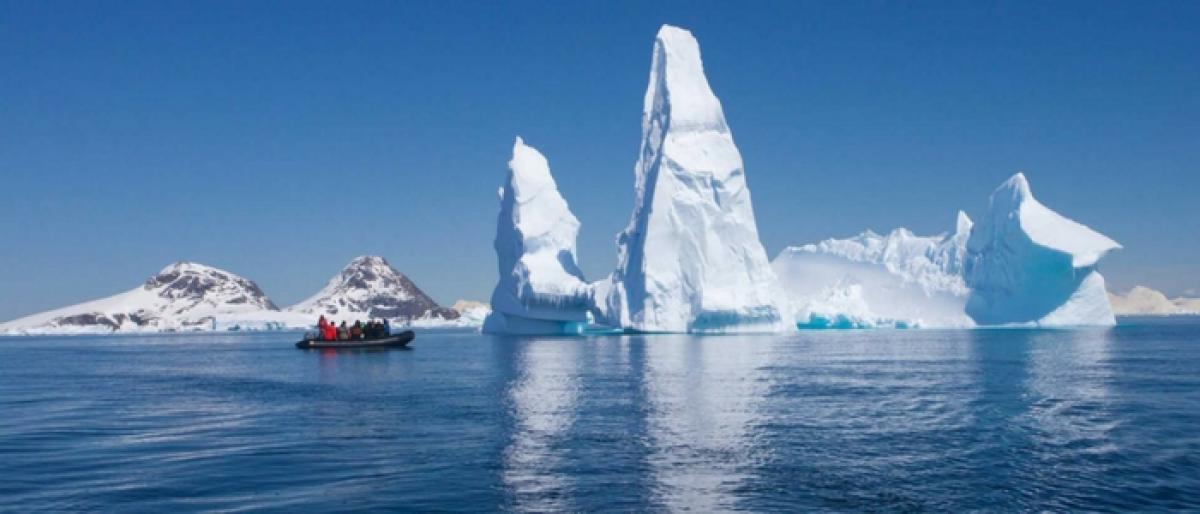Iceberg! Right ahead

Protesting the indifference of politicians towards the climate change environmentalists expressed their discontentment with massive protests at Hamburg, where G-20 leaders assembled for the Summit meet.
The colossal breaking of 12 trillion cubic meters Antarctic Larsen C ice shelf is an inimical off-shoot of climate change and can have dire consequences. While the immediate effects of this event are not ominous, scientists are carefully monitoring rest of the ice shelf closely
Debates of climate changed picked up traction with ignoble US president announcing the withdrawal of America from the Paris Climate Accord.
Protesting the indifference of politicians towards the climate change environmentalists expressed their discontentment with massive protests at Hamburg, where G-20 leaders assembled for the Summit meet.
Days after the conclusion of the Summit, European Space Agency, Sentinel-1 mission, announced that Larsen C ice shelf, the fourth largest in the world (5,800 sq km) comprising of 12 per cent of total area of Antarctica broke off from the frozen continent.
Ice shelves are humongous repositories, which are formed when glaciers on land begin to spread out over the sea. They essentially prevent the drifting of glacial ice into the sea and thereby regulate sea level rise. In general, glacial ice chips off to form icebergs.
Now snapping of 12 trillion cubic meters of ice, larger than Haryana, is believed to change the landscape of Antarctica. While the immediate effects of this event are not ominous, scientists are carefully monitoring rest of the ice shelf closely.
The ice shelf, which looks like a crooked finger is pointing towards the tip of the South America is an extension of huge West Antarctic Ice Sheet (WAIS). The ice shelf when ripped off completely will exist as a 190-metre-thick iceberg nearly four times the height of Qutub Minar.
Indeed, fissures in the Larsen C ice shelf first appeared in 2010. The tear which spread 10 metres per day gradually accelerated to 36 mt before finally snapped away on July 12. The splintering of the ice shelf has already begun and the smaller icebergs are now heading towards the Weddell Sea. Experts at Scripps Institute of Oceanography said that ice fragments might eventually move further north towards South Georgia and the South Sandwich Islands.
The breaking of ice shelf is a natural process. Antarctica ice is tightly compressed at the edges of its rocky base and under the weight of huge ice accumulations, ice shelves break off from time to time. Hence breaking of ice shelves can’t be attributed to global warming directly.
But what caught the attention of the scientists is the shortened frequency of the calving (breaking of ice shelves) process. Ice shelves, which form 75 per cent of coastal Antarctica are susceptible to changes in atmospheric temperature from above and ocean warming from below. Although the role of warm climates in triggering calving is not scientifically established as of now, experts believe don’t belie its role.
The gigantic icy continent is firmly edged by ice shelves, which form the coastal region while glaciers impound inlands. Thwaites glaciers, a gigantic bulk of ice part of the West Antarctica Ice Sheet, located further inland has become the cause of intense concern.
Rapidly changing climates led to melting and sliding of the glaciers into sea pushing up sea levels. Unchecked greenhouse gas emissions accentuate melting of glaciers. It is estimated that melting of West Antarctica Ice Sheet can increase sea level by 3 meters.
On the contrary, ice shelf breaking may not increase the sea level since this portion of ice was already in the water. The volume of water produced after the ice shelf melting is equal to the volume of ice that was displaced.
But calving of ice shelf and its gradual melting will greatly destabilise the land ice. Though scientists are hopeful that ice-shelf will regrow but chipping away of huge chunks of ice shelves at regular intervals will inadvertently make Antarctica less stable.
If the newly calved iceberg drifts into warm oceans, it can just long for a few decades. Ice shelves act as sinks for glaciers and their calving will eventually hasten the melting of glaciers leading to increasing in sea level. In 2015, a report in the reputed journal Science warned that ice shelves in Antarctica are thinning at an accelerated pace and that ice shelves ceased to gain volume.
Larsen Shelf is named after the Norwegian explorer Carl Anton Larsen who in 1890, sailed along the 1000km western coastal stretch. The Larsen shelf comprises of distinct shelves- Larsen A, B, C and D. In 1995, Larsen A broke away and melted completely in seven years.
The 10,000 years old Larsen B separated from Antarctica in 2002 and became an iceberg. Reports showed that Larsen B calving speeded up glacier collapse by 300 to 800 per cent. Larsen C is five times the size of Larsen B. NASA scientist Cavin Schmidt said that complete melt down of Larsen C might increase sea level by 0.1mm.
Intergovernmental Panel on Climate Changes Fifth Assessment Report (5AR), indicated that temperatures in the Antarctic peninsula where Larsen C is located, are rising four to six times that of the global average.
Although the role of global warming wasn’t scientifically established as of now, reputed scientific journal, Nature, opined that increased human (anthropogenic) activity in Antarctica is posing a new threat. The surge in a number of tourists visiting Antarctica is drastically changing the delicate ecosystem of Antarctica.
Especially visitors to coastal regions has increased from 1.5 million in 2004-05 to 2.6 million in 2013-14. Interestingly, Antarctica is in news recently for being the venue for first ever wedding ceremony of expedition leaders of British Antarctica Survey (BAS).
As per IPCC reports the twentieth century witnessed a linear increase of sea level caused by warmer oceans and melting glaciers. In 21st century rise of sea level is exponential because of melting of fast flowing glaciers and subsequent breaking of ice shelves of Greenland and Antarctica.
Already islands in the Pacific Ocean, Indian Ocean and countries with huge coasts are facing the inimical effects of global warming. Besides the impending threats of inundation, rising sea levels are critically endangering livelihoods of thousands of people living along the coasts. Fertile cultivable lands are rendered barren by salty depositions. Fresh water resources are becoming salty.
Mounting pieces of evidence unequivocally indicate that unscrupulous human activity has irrevocably disturbed the delicate balance of nature. The irreversible damage can be controlled through collective action and committed nurture.
It is time international collaboration be ramped up to tame the disastrous cycle of events triggered by global warming. But sadly, overpowered by ritualistic nationalism, America, the biggest emitter of greenhouse gases is dragging its feet.
Abdicating responsibilities towards environment will push us closer to a brink of self-inflicted catastrophic consequences. Calving of Antarctic ice shelf is an inimical distress signal lest the world chooses to brush it off at its own peril.
















